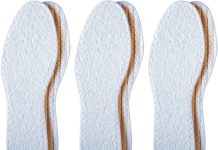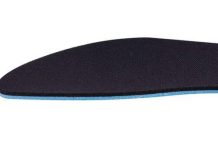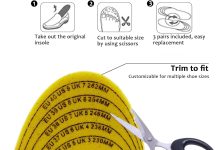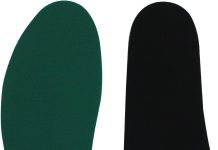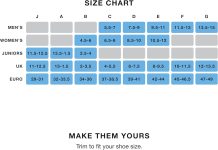If you’re experiencing pain and discomfort from Morton’s Neuroma, you might be wondering how insoles can provide relief. Luckily, these small inserts can make a big difference in managing the symptoms of this condition. By providing cushioning and support, insoles help to reduce pressure on the affected nerve, allowing you to walk and move more comfortably.
In this article, we’ll explore the benefits of using insoles for Morton’s Neuroma and how they can play a crucial role in your overall treatment plan. So, let’s dive in and discover the ways insoles can help alleviate your discomfort and get you back on your feet with ease.
What is Morton’s Neuroma?
Definition
Morton’s Neuroma is a condition that affects the nerves in the foot, causing pain and discomfort. Specifically, it is the thickening of tissue around a nerve leading to the toes, usually between the third and fourth toes. This can result in sharp, burning pain, numbness, tingling, and the sensation of a pebble or marble under the foot.
Causes
The exact cause of Morton’s Neuroma is not fully understood, but several factors can contribute to its development. These include wearing tight or ill-fitting footwear, high heels, repetitive stress on the feet, certain foot deformities, and underlying biomechanical issues that affect foot function.
Symptoms
The most common symptom of Morton’s Neuroma is pain, which can range from mild to severe. This pain is often worsened by walking or wearing tight shoes. Other symptoms include a burning sensation, numbness, tingling, and the feeling that something is in the shoe, like a small stone. These symptoms may come and go, but if left untreated, they can worsen.
Understanding Insoles
Definition
Insoles, or orthotics or shoe inserts, are devices placed inside shoes to provide support, cushioning, and correction to the feet. They are designed to distribute pressure evenly across the foot, absorb shock, and improve foot alignment.
Types of Insoles
There are different types of insoles available, and each serves a specific purpose. Arch support insoles are designed to support and relieve pressure on the foot’s arch. Cushioning insoles are intended to provide extra padding and shock absorption. Orthotic insoles are custom-made to address specific foot issues and provide personalized support. Gel insoles are filled with gel material to provide cushioning and reduce pressure points.
How to do Insoles Work
Insoles work by altering the foot biomechanics to alleviate pain and discomfort. They provide support and stability to the arch of the foot, which helps redistribute pressure and alleviate strain on the affected nerve. Insoles also act as shock absorbers, reducing the impact on the foot with each step. Additionally, insoles help correct foot alignment, ensuring that the foot functions correctly, which can further reduce the risk of aggravating Morton’s Neuroma.
Benefits of Insoles for Morton’s Neuroma
Pressure Redistribution
One of the key benefits of using insoles for Morton’s Neuroma is their ability to redistribute pressure on the foot. By supporting the arch and cushioning the affected area, insoles help alleviate the pressure on the injured nerve, reducing pain and discomfort.
Shock Absorption
Insoles with shock-absorbing properties help cushion the foot and reduce the impact of each step. This can significantly reduce the nerve strain and relieve the pain associated with Morton’s Neuroma.
Improved Foot Alignment
Proper foot alignment is crucial for optimal foot function and preventing excessive pressure on specific areas. Insoles can help correct foot alignment by providing support and stability, ensuring that weight is evenly distributed across the foot. This can alleviate pressure on the affected nerve and promote better foot mechanics.
Reduced Friction and Irritation
Ill-fitting shoes can cause friction and irritation on the foot, exacerbating the symptoms of Morton’s Neuroma. Insoles act as a barrier between the foot and the shoe, reducing friction and preventing the formation of painful corns and calluses. By reducing friction and irritation, insoles can provide much-needed relief for Morton’s Neuroma.
Choosing the Right Insoles
Podiatrist Consultation
Before selecting insoles for Morton’s Neuroma, it is essential to consult with a podiatrist or a foot specialist. They can assess your foot condition, determine the severity of your Morton’s Neuroma, and recommend the most suitable insoles for your specific needs.
Custom-Made vs. Over-the-Counter Options
Regarding insoles, there are both custom-made and over-the-counter options available. Custom-made insoles are designed to address individual foot issues and provide personalized support. While they tend to be more expensive, they offer a higher level of customization and can be more effective in managing Morton’s Neuroma. Over-the-counter insoles, on the other hand, are readily available and can provide some relief, but they may not be as tailored to your specific foot condition.
Considerations for Shoe Type
Different shoe types may require different types of insoles. For example, if you primarily wear athletic shoes, you may need insoles with extra cushioning and shock absorption. On the other hand, if you wear dress shoes or heels, you may require insoles that provide support and stability while fitting comfortably in tighter footwear. Consider your daily activities and shoe choices when selecting the right insoles for your needs.
Material and Cushioning
The material and cushioning of the insoles can make a significant difference in their effectiveness. Look for insoles made from high-quality materials that offer adequate cushioning and shock absorption. Gel or foam-based cushioning can provide excellent comfort and support while helping to alleviate the symptoms of Morton’s Neuroma.
Wearing Insoles for Morton’s Neuroma
Inserting Insoles
When inserting insoles into your shoes, follow the manufacturer’s instructions to ensure proper placement. Most insoles can be easily inserted and adjusted for a comfortable fit. Ensure the insoles are positioned correctly to support the arch and cushion the affected area.
Ensuring Proper Fit
Proper fit is essential for the effective use of insoles. Ensure that the insoles match the size and shape of your shoes. If necessary, trim the insoles to fit your shoes perfectly. Ill-fitting insoles can cause discomfort and may not provide the desired support and relief.
Getting Accustomed to Insoles
It may take time for your feet to adjust to wearing insoles. Start by wearing them for short periods, gradually increasing the duration as your feet get accustomed to the new support. If you experience any discomfort or pain while wearing the insoles, remove them and consult with a podiatrist for further guidance.
Replacing Insoles Regularly
Insoles will eventually wear out and lose their effectiveness. Regularly check the condition of your insoles and replace them as needed. Depending on the usage and quality of the insoles, they may need to be replaced every six to twelve months to ensure continued support and relief.
Alternative Footwear Options
Orthopedic Shoes
Orthopedic shoes are designed to provide support, stability, and comfort for individuals with foot conditions such as Morton’s Neuroma. These shoes often have unique features like a wider toe box, extra cushioning, and arch support. They can help alleviate pressure on the affected nerves and provide long-lasting relief.
Shoe Modifications
In some cases, modifying your existing shoes can provide additional relief for Morton’s Neuroma. This may involve stretching or widening the shoe to accommodate the affected area, adding extra padding, or utilizing shoe inserts designed explicitly for Morton’s Neuroma. A podiatrist can advise on the most suitable shoe modifications for your needs.
Toe Spacers
Toe spacers are devices between the toes to help separate and realign them. These can be particularly beneficial for Morton’s Neuroma, as they can help relieve pressure and reduce friction on the affected area. Toe spacers are available in various materials and sizes, and they can be worn inside shoes to provide continuous relief throughout the day.
Combining Insoles with Other Treatments
Physical Therapy
Physical therapy can be an effective complement to using insoles for Morton’s Neuroma. A physical therapist can provide specific exercises and stretches to improve foot strength, flexibility, and overall function. These exercises can help alleviate pain, promote healing, and prevent further aggravation.
Corticosteroid Injections
In some cases, corticosteroid injections may be recommended to reduce inflammation and alleviate pain associated with Morton’s Neuroma. These injections can provide temporary relief and can be combined with insoles for optimal results. However, it is essential to note that corticosteroid injections are typically used as a short-term solution and should be administered by a healthcare professional.
Anti-inflammatory Medication
Over-the-counter or prescription nonsteroidal anti-inflammatory drugs (NSAIDs) may be recommended to manage pain and inflammation caused by Morton’s Neuroma. These medications can help reduce swelling, alleviate pain, and complement the use of insoles in providing relief. It is essential to consult with a healthcare professional before starting any medication regimen.
Foot Stretching Exercises
Stretching exercises can help improve the flexibility and range of motion of the foot, relieving Morton’s Neuroma. These exercises can be done at home and may include stretching the toes, calf muscles, and plantar fascia. Regular stretching can help reduce pain and discomfort, improve foot function, and enhance the effectiveness of insoles.
When to Seek Professional Help
Persistent or Severe Symptoms
If you experience persistent or severe symptoms of Morton’s Neuroma despite using insoles and other conservative treatments, it is essential to seek professional medical help. A podiatrist or foot specialist can evaluate your condition, recommend additional treatment options, and determine if further interventions, such as surgery, are necessary.
Limited Relief from Insoles
While insoles can effectively manage Morton’s Neuroma for many individuals, some may find limited relief or inadequate support. Suppose your insoles do not provide the desired level of comfort and relief. In that case, it is essential to consult with a podiatrist who can assess your feet and recommend alternative options that may better suit your specific needs.
Signs of Nerve Damage
If you experience signs of nerve damage, such as persistent numbness, muscle weakness, or changes in sensation, it is crucial to seek immediate medical attention. These symptoms may indicate a more severe underlying condition and require prompt intervention for proper diagnosis and treatment.
Preventing Morton’s Neuroma
Wearing Properly Fitting Shoes
Wearing footwear that fits properly is essential for preventing Morton’s Neuroma. Avoid shoes that are too tight or have a narrow toe box, as they can compress the toes and increase the risk of nerve irritation. Opt for shoes that provide adequate support, cushioning, and enough room for your toes to move freely.
Avoiding High Heels and Pointed-Toe Shoes
High heels and shoes with pointed-toe designs can put excessive pressure on the front of the foot, increasing the risk of developing Morton’s Neuroma. It is advisable to limit or avoid wearing such footwear to minimize the strain on the nerves and reduce the chances of developing the condition.
Maintaining a Healthy Weight
Maintaining a healthy weight can significantly reduce the stress on the feet, including the nerves. Excess weight can put additional pressure on the foot structures and contribute to the development or exacerbation of Morton’s Neuroma. By maintaining a healthy weight, you can help prevent the onset of this condition and alleviate symptoms if already present.
Regularly Exercising Feet
Regular exercise can help strengthen the feet, increase flexibility, and improve overall foot health. Specific foot exercises, such as toe curls, arch strengthening, and stretching routines, can help maintain proper foot mechanics and prevent conditions like Morton’s Neuroma. Incorporate foot exercises into your daily routine to keep your feet healthy and strong.
Conclusion
Insoles can be a valuable tool in managing the pain and discomfort associated with Morton’s Neuroma. By providing support, cushioning, and improved foot alignment, insoles can help alleviate pressure on the affected nerve, absorb shock, and reduce friction.
When combined with other treatments and preventive measures, such as appropriate footwear and foot exercises, insoles can improve foot health and overall well-being. If you are suffering from Morton’s Neuroma, consult with a podiatrist to find the right insoles that meet your specific needs and start experiencing the benefits today.




